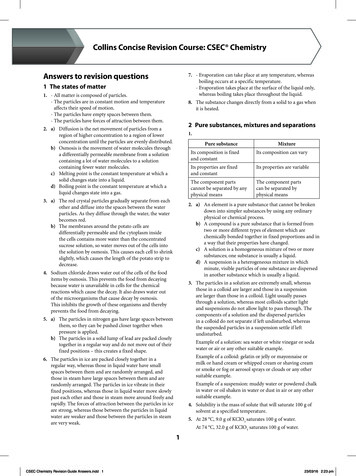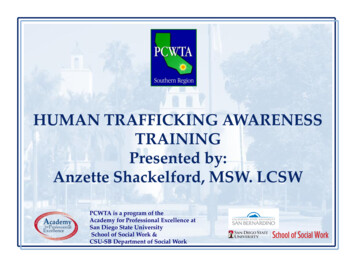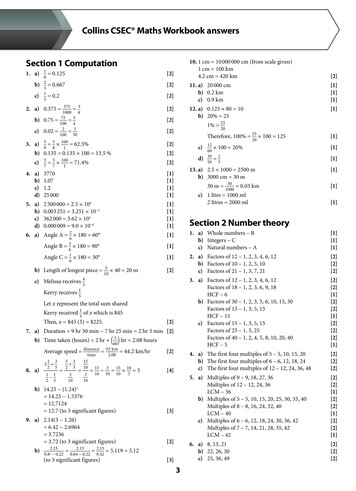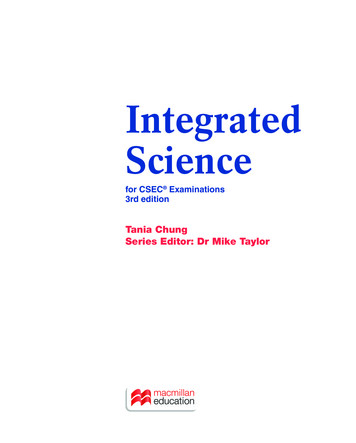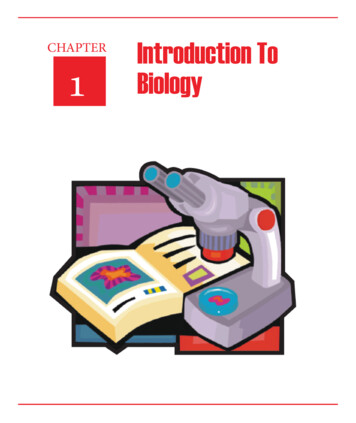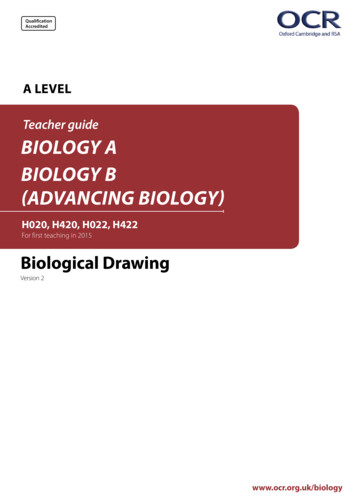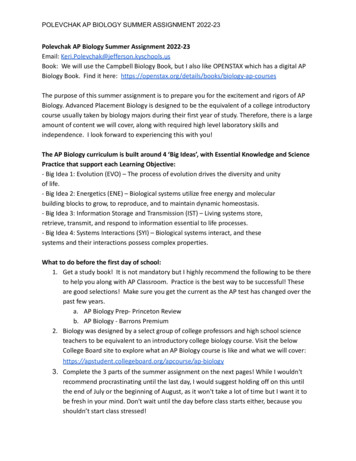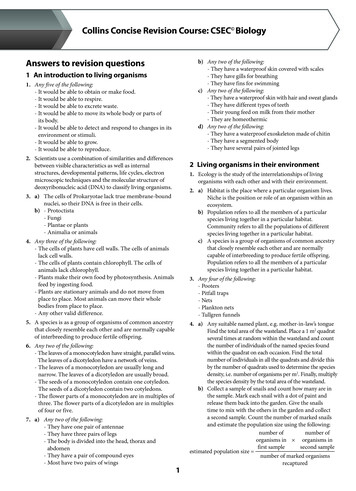
Transcription
Collins Concise Revision Course: CSEC Biologyb) Any two of the following:- They have a waterproof skin covered with scales- They have gills for breathing- They have fins for swimmingc) Any two of the following:- They have a waterproof skin with hair and sweat glands- They have different types of teeth- Their young feed on milk from their mother- They are homeothermicd) Any two of the following:- They have a waterproof exoskeleton made of chitin- They have a segmented body- They have several pairs of jointed legsAnswers to revision questions1 An introduction to living organisms1. Any five of the following:- It would be able to obtain or make food.- It would be able to respire.- It would be able to excrete waste.- It would be able to move its whole body or parts ofits body.- It would be able to detect and respond to changes in itsenvironment or stimuli.- It would be able to grow.- It would be able to reproduce.2. Scientists use a combination of similarities and differencesbetween visible characteristics as well as internalstructures, developmental patterns, life cycles, electronmicroscopic techniques and the molecular structure ofdeoxyribonucleic acid (DNA) to classify living organisms.2 Living organisms in their environment1. Ecology is the study of the interrelationships of livingorganisms with each other and with their environment.2. a) Habitat is the place where a particular organism lives.Niche is the position or role of an organism within anecosystem.b) Population refers to all the members of a particularspecies living together in a particular habitat.Community refers to all the populations of differentspecies living together in a particular habitat.c) A species is a group of organisms of common ancestrythat closely resemble each other and are normallycapable of interbreeding to produce fertile offspring.Population refers to all the members of a particularspecies living together in a particular habitat.3. a) The cells of Prokaryotae lack true membrane-boundnuclei, so their DNA is free in their cells.b) - Protoctista- Fungi- Plantae or plants- Animalia or animals4. Any three of the following:- The cells of plants have cell walls. The cells of animalslack cell walls.- The cells of plants contain chlorophyll. The cells ofanimals lack chlorophyll.- Plants make their own food by photosynthesis. Animalsfeed by ingesting food.- Plants are stationary animals and do not move fromplace to place. Most animals can move their wholebodies from place to place.- Any other valid difference.3. Any four of the following:- Pooters- Pitfall traps- Nets- Plankton nets- Tullgren funnels5. A species is as a group of organisms of common ancestrythat closely resemble each other and are normally capableof interbreeding to produce fertile offspring.4. a) Any suitable named plant, e.g. mother-in-law’s tongueFind the total area of the wasteland. Place a 1 m2 quadratseveral times at random within the wasteland and countthe number of individuals of the named species foundwithin the quadrat on each occasion. Find the totalnumber of individuals in all the quadrats and divide thisby the number of quadrats used to determine the speciesdensity, i.e. number of organisms per m2. Finally, multiplythe species density by the total area of the wasteland.b) Collect a sample of snails and count how many are inthe sample. Mark each snail with a dot of paint andrelease them back into the garden. Give the snailstime to mix with the others in the garden and collecta second sample. Count the number of marked snailsand estimate the population size using the following:number ofnumber oforganisms in organisms infirst samplesecond sampleestimated population size number of marked organismsrecaptured6. Any two of the following:- The leaves of a monocotyledon have straight, parallel veins.The leaves of a dicotyledon have a network of veins.- The leaves of a monocotyledon are usually long andnarrow. The leaves of a dicotyledon are usually broad.- The seeds of a monocotyledon contain one cotyledon.The seeds of a dicotyledon contain two cotyledons.- The flower parts of a monocotyledon are in multiples ofthree. The flower parts of a dicotyledon are in multiplesof four or five.7. a) Any two of the following:- They have one pair of antennae- They have three pairs of legs- The body is divided into the head, thorax andabdomen- They have a pair of compound eyes- Most have two pairs of wings1
5. Environment refers to the combination of factors whichsurround and act upon an organismthey use to manufacture proteins. The bacteria gainfood produced by the plants in photosynthesis, andprotection.- Coral polyps and algaeThe polyps gain food and oxygen as the algaephotosynthesise. The algae gain carbon dioxide as thepolyps respire, nitrogenous compounds excreted bythe polyps, and protection.- Termites and protozoansThe termites gain digested food. The protozoans gainfood eaten by the termites, and protection.- Any other valid exampleb) Any one of the following:- Epiphytes growing on treesThe epiphytes gain support, and are positionedwhere they are close to sunlight and out of reach ofherbivores on the ground. The trees do not gain anybenefit nor are harmed.- Cattle egrets and cowsThe egrets gain food by eating ticks from the cow’sskin and insects that the cow disturbs as it movesthrough grass. The cows do not gain any real benefitother than having the ticks removed from their skins,and they are not harmed.- Ramoras and sharksThe ramoras gain food scraps left by the sharks asthey feed. The sharks do not gain benefit nor areharmed.- Any other valid examplec) Any one of the following:- Lice and ticks on mammals such as cattleThe lice and ticks gain food by sucking blood. Thecattle suffer damage to their hides, they become weak,and can also suffer from anaemia and tick paralysis.- Tapeworms in humansThe tapeworms gain digested food, shelter andprotection. The human suffers from abdominal pain,loss of appetite, weight loss and nausea.- The malaria parasite or Plasmodium in humansThe parasites gain food from the human’s liver andred blood cells. The human suffers from a recurrentfever.- Dodder or love vine on other plantsThe dodder gains food from the plant’s phloem. Theplant suffers from reduced growth.- Any other valid example6. The biotic environment is composed of all the other livingorganisms which are present. The abiotic environmentis composed of all the non-living chemical and physicalfactors.7. a) Water is essential for photosynthesis in plants, todissolve minerals so they can be absorbed by plant rootsand to prevent the desiccation of soil organisms withoutwaterproof body coverings such as earthworms.b) Oxygen in the air is essential for plant roots and soilorganisms to respire aerobically, and for bacteriaand fungi to decompose organic matter aerobicallyto form humus. Nitrogen in the air is necessary fornitrogen fixing bacteria to form inorganic nitrogenouscompounds such as nitrates.c) Mineral nutrients are essential for the healthy growthof plants.8. a) Light is essential for plants to make food byphotosynthesis. Light synchronises activities of plantsand animals with the seasons, such as flowering inplants, and migration, hibernation and reproductionin animals.b) Temperature affects the rate of photosynthesis andgermination in plants and the activity of animals,for example many animals become dormant at lowtemperatures.c) Oxygen in the air is essential for aerobic respiration inalmost all living organisms, carbon dioxide is essentialfor photosynthesis in plants, and pollutant gases have anegative effect on living organisms.3 Interrelationships between livingorganisms1. tomato plantsdragonfliesaphidstoadsladybird beetles2. a) Any one of the following:- Ladybird beetle- Dragonfly- Toadb) Aphidc) Tomato plantd) Aphide) Ladybird beetlef) Any one of the following:- Ladybird beetles and aphids- Dragonflies and ladybird beetles- Toads and dragonflies6. Food chains rarely contain more than four or five trophiclevels because energy and biomass are lost at eachsuccessive level in the food chain.7. Materials are continually recycled in nature so that theydo not run out. All living organisms contain water, carbonin organic compounds and nitrogen in proteins. Water,carbon and nitrogen are continually recycled. Water isrecycled to ensure plants have a continuous supply forphotosynthesis, all organisms have a continuous supply tokeep their cells hydrated and to act as a solvent, and aquaticorganisms have a constant environment in which to live.Carbon is recycled to ensure plants have a continuoussupply of carbon dioxide to manufacture organic food byphotosynthesis and this ensures animals have a continuoussupply of food. Nitrogen is recycled to ensure plants have3. Decomposers are micro-organisms that feedsaprophytically on dead and waste organic matter causingit to decompose.They are essential within ecosystems to recycle carbondioxide and mineral nutrients.4. A symbiotic relationship is any close relationship betweentwo organisms of different species.5. a) Any one of the following:- Leguminous plants and nitrogen fixing bacteriaThe plants gain nitrogenous compounds which2
a continuous supply of nitrates to manufacture proteinsand this ensures that animals and decomposers have acontinuous supply of proteins.atmosphere, where they contribute to the greenhouseeffect. Hydrogen sulfide gas can be released into theair and harm eyes and respiratory systems. Plastics canenter waterways and oceans, where they are harmful toaquatic organisms. Bacteria from untreated sewage canenter groundwater and cause disease. Garbage can attractrodents, which can spread disease and create an eyesore.8. Any four of the following:- To prevent wastage of potentially useful materials- To conserve natural resources- To reduce energy usage- To reduce the quantity of waste requiring disposal- To reduce pollution of air, land and water5. - They contribute to the economies of Caribbean countriesby providing attractions and recreational sites for tourists.- They contribute to the economies of Caribbean countriesby supporting fishing industries.- They provide coastal protection for Caribbean countriesagainst wave action, tidal forces and flooding.9. Any three of the following:- It can be difficult to persuade households and industriesto separate their waste into different types.- It is more difficult to collect, transport and store wasteitems when separated into different types.- It can be time consuming to clean and sort items.- It can be hazardous when separating recyclable materialsfrom toxic materials.- It can be uneconomical because it is labour and energyintensive.- Most small countries of the Caribbean do not have thefacilities to use recycled raw materials.6. Any three of the following:- Carbon dioxide- Water vapour- Dinitrogen monoxide or nitrous oxide- Methane- Fluorinated gases- OzoneGreenhouse gases form a layer around the Earth that letsradiation from the Sun pass through, but prevents much ofit being reflected back into space. This radiationcauses warming of the Earth, which is known as thegreenhouse effect.4 The impact of humans on the environment1. Non-renewable resources are present in the Earth in finiteamounts and cannot be replaced, e.g. energy resourcessuch as fossil fuels and radioactive fuels, and mineralresources. Renewable resources can be replaced by naturalprocesses, e.g. fish, trees, soil.Human activities are causing non-renewable resources torun out, and renewable resources to be overexploited suchthat their numbers are decreasing, in some cases to thepoint of extinction.7. Any four of the following:- Polar ice caps and glaciers will melt.- Sea levels will rise.- Low lying coastal areas will flood.- Global weather patterns will change.- More severe weather events and natural disasterswill occur.- Ecosystems will change.- Some diseases will become more widespread.- Corals will bleach and die.2. Chemical fertilisers contain nitrate and phosphate ions.If these ions enter aquatic environments in sufficientquantities they cause the rapid growth of green plants andalgae. The plants and algae die and are decomposed byaerobic bacteria which multiply and use up the dissolvedoxygen. This causes other aquatic organisms to die.8. Any five of the following:- Conserve and restore natural resources, e.g. usealternative energy sources, replace renewable resources,reuse and recycle resources, reduce soil erosion, set upbreeding programmes and nature reserves.- Reduce pollution, e.g. use alternative energy sources,organic fertilisers and biodegradable pesticides, disposeof waste using appropriate methods.- Develop educational programmes for people of all ages.- Implement monitoring programmes to continually assessthe health of ecosystems.- Practise organic agriculture.- Sign international agreements to control pollution andconserve natural resources.- Pass legislation to protect the environment.- Any other valid suggestion3. a) Sulfur dioxide causes respiratory problems and reducesthe growth of green plants. It dissolves in rainwaterforming acid rain which decreases the pH of the soil,damages plants, harms animals, corrodes buildings,and causes lakes, streams and rivers to become acidicand unsuitable for aquatic organisms. It also combineswith water vapour and smoke, forming smog, whichcauses respiratory problems.b) Carbon monoxide combines with haemoglobin moreeasily than oxygen, which reduces the amount ofoxygen reaching body tissues. This reduces respirationin cells and mental awareness. It causes dizziness,headaches and visual impairment, and can lead tounconsciousness and death.c) Carbon particles in smoke coat leaves, which reducesphotosynthesis, and the smoke combines with watervapour and sulfur dioxide to form smog, which causesrespiratory problems.9. Any four of the following:- Availability of food.- Competition for space, a mate, food and shelter.- Spread of disease.- Presence of predators.- Natural disasters.- Invasive species and pests.4. Toxic chemicals in the garbage can leach out andcontaminate the soil, aquatic environments and watersources. Greenhouse gases can be released into the3
5 Cells1.vacuoles – small, membrane-bound compartments whichmay contain water, food, cell secretions or waste productscell membrane – a differentially permeable layercomposed of protein and lipid around the outsideof the cellcytoplasm – a jelly-like substance composedof about 80% water and 20% dissolvedsubstances, especially proteinnucleus – surrounded by a double membrane.Contains nucleoplasm, a nucleolus andchromatin threads of DNAmitochondrion – a rod-shaped organelle witha smooth outer membrane and folded innermembrane. Contains respiratory enzymesglycogen granule2. Any three of the following:- Glycogen granules – serve as a food store.- Cell membrane – forms a layer around the outside of thecell that controls what enters and leaves the cell.- Cytoplasm – supports the organelles and is the site ofmany chemical reactions.- Nucleus – controls the characteristics and functioning ofthe cell and is essential for the cell to divide.- Mitochondrion – where respiration occurs to produceenergy.cell, this cell has to carry out all essential life processes andcannot become specialised.6. A tissue is a group of cells all of the same type or, in somecases, more than one type, which work together to carryout a particular function.7. Animal tissues;Any two of the following:- Nerve tissue. Conducts nerve impulses.- Muscle tissue. Brings about movement.- Epithelial tissue. Covers and protects inner and outersurfaces of the body.- Blood tissue, a type of connective tissue. Transportssubstances around the body and helps fight disease.- Adipose tissue or fat tissue, a type of connective tissue.Insulates the body, serves as a food reserve and acts aspadding to protect the body.- Any other suitable connective tissue.3. Any four of the following:- An animal cell does not have a cell wall. A plant cell has acell wall.- An animal cell does not have chloroplasts or chlorophyll.A plant cell has chloroplasts containing chlorophyll.- An animal cell may have small vacuoles with differingcontents scattered throughout the cytoplasm. A plant cellhas one large, central vacuole containing cell sap.- Animal cells may contain glycogen granules as a foodstore. Plant cells may contain starch grains as a food store.- Animal cells can have a variety of different shapes. Plantcells are usually round, square or rectangular.Plant tissues;Any two of the following:- Epidermal tissue. Protects the surfaces of leaves, stemsand roots.- Packing tissue. Fills spaces in stems and roots, supportsnon-woody plants when turgid and stores food.- Photosynthetic tissue. Makes food by photosynthesis.- Vascular tissue. Transports water, mineral salts anddissolved food substances, and provides support.4. A bacterial cell would lack a true nucleus and othermembrane-bound organelles such as mitochondria foundin other cells. Instead of a true nucleus, their DNA wouldbe seen in a region called the nucleoid which would lacka nuclear membrane, and also in smaller regions calledplasmids throughout their cytoplasm.8. Diffusion is the net movement of particles from an areaof higher concentration to an area of lower concentrationuntil the particles are evenly distributed.5. Cells in the bodies of multicellular organisms becomespecialised to carry out specific functions to enablemulticellular organisms to carry out all essential lifeprocesses efficiently. By becoming specialised, these cellsare better able to carry out their specific functions. Sincethe bodies of unicellular organisms consist of only one9. Any four of the following:- Oxygen, for use in aerobic respiration, moves intoorganisms through gaseous exchange surfaces and intocells by diffusion.4
- Carbon dioxide, produced in aerobic respiration, movesout of cells and out of organisms through gaseousexchange surfaces by diffusion.- Carbon dioxide, for use in photosynthesis, moves intoleaves and plant cells by diffusion.- Oxygen, produced in photosynthesis, moves out of plantcells and leaves by diffusion.- Some of the glucose and amino acids produced indigestion are absorbed through the cells in the ileum andcapillary walls and into the blood by diffusion.3. Test to confirm the identity of XAdd a few drops of iodine solution to X and shake. Itshould turn blue-black.Test to confirm the identity of YAdd an equal volume of Benedict’s solution, shake and heatthe mixture. An orange-red precipitate should form.Test to confirm the identity of ZAny one of the following:- Add an equal volume of sodium hydroxide solution,shake, add drops of copper sulfate solution and shakeagain. It should turn purple.- Add an equal volume of biuret reagent and shake. Itshould turn purple.10. Osmosis is the movement of water molecules througha differentially permeable membrane from a solutioncontaining a lot of water molecules, e.g. a dilute solution(or water), to a solution containing fewer water molecules,e.g. a concentrated solution.4. Enzymes are biological catalysts produced by all livingcells. They speed up chemical reactions occurring in livingorganisms without being changed themselves.11. Water enters the cytoplasm and cell sap by osmosis. Thiscauses the cytoplasm and vacuole to swell and press outwardson the cell wall, which causes the cell to become turgid.5. Amylase6. As temperature increases from 0 C, the rate of enzymeactivity increases until the optimum temperature isreached, this being about 37 C for human enzymes. Astemperature increases above the optimum temperature,the rate of enzyme activity decreases. Enzymes begin to bedenatured at about 40 C to 45 C and most are denaturedby about 55 C.12. Any four of the following:- Cells are kept hydrated by water moving into them byosmosis.- Plant cells are kept turgid by water moving into them byosmosis. This causes non-woody stems to stand uprightand keeps leaves firm.- Water is kept moving through plants by osmosisoccurring in the cells of roots and leaves. This ensuresthat leaves get water for photosynthesis.- The size of stomatal pores is regulated by osmosisoccurring in the guard cells. This controls the loss ofwater from the leaves of plants.- Water is reabsorbed into the blood from the filtrate in thekidney tubules by osmosis. This prevents the body fromlosing too much water.7. Any three of the following:- Enzymes are specific, each type catalyses only one type ofreaction.- Enzymes work best at a particular pH.- Most enzymes are denatured by extremes of acidity andalkalinity.- The action of enzymes is helped by certain vitamins andminerals.- The action of enzymes is inhibited by certain poisons.13. Since the poison prevents respiration from occurring inthe root, the energy needed to move mineral salts from thesoil through the membranes of the root cells into the rootcannot be made.7 Nutrition1. During autotrophic nutrition organisms called autotrophsuse a source of energy and simple inorganic compoundssuch as carbon dioxide, water and minerals to manufacturecomplex organic food substances. During heterotrophicnutrition organisms called heterotrophs obtain ready-madeorganic food from their environment.6 The chemistry of living organisms1. a) Polysaccharide molecules are composed of carbon,hydrogen and oxygen atoms. These atoms formsmall molecules called monosaccharides which havethe formula C6H12O6. Polysaccharide molecules areformed by the condensation of many monosaccharidemolecules into straight or branched chains and havethe formula (C6H10O5)n.b) Protein molecules are composed of carbon, hydrogen,oxygen, nitrogen, and sometimes sulfur andphosphorus atoms. These atoms form small moleculescalled amino acids. Protein molecules are formed bythe condensation of hundreds or thousands of aminoacid molecules in long chains.c) Lipid molecules are composed of carbon, hydrogenand oxygen atoms. Each lipid molecule is made up offour smaller molecules joined together, three fatty acidmolecules and one glycerol molecule.2. When an organism feeds saprophytically it obtainsorganic food from the dead remains of other organisms bydigesting complex organic food outside their bodies andthen absorbing the simpler organic substances produced.3. A green leaf manufactures glucose by photosynthesis.During the light stage, the chlorophyll in chloroplasts ofthe leaf absorbs sunlight energy and uses it to split watermolecules into hydrogen and oxygen. During the darkstage, the hydrogen atoms produced in the light stagereduce the carbon dioxide molecules, forming glucose.The dark stage requires enzymes.4. 6CO2 6H2O2. Condensation involves joining molecules together with theloss of water. Hydrolysis involves splitting molecules byadding water.5sunlight energy absorbedC6H12O6 6O2by chlorophyll
11.5. Any four of the following:- Waxy cuticles on the outside of both the upper and lowerepidermis of the leaf are waterproof so they can preventleaves losing water which is needed for photosynthesis.- Stomatal pores are present throughout the lowerepidermis and allow carbon dioxide to diffuse into theleaf and oxygen to diffuse out.- The palisade mesophyll cells are directly below the upperepidermis and closest to the sunlight, and contain a largenumber of chloroplasts to maximise the amount of lightenergy absorbed.- The palisade mesophyll cells are arranged at 90 to theleaf ’s surface to minimise the loss of sunlight energy thatoccurs as it passes through cell walls, and to allow thechloroplasts to move to the top of the cells in dim light tomaximise the amount of light absorbed.- Intercellular air spaces between the spongy mesophyllcells allow carbon dioxide to diffuse to all the mesophyllcells and oxygen to diffuse away.- Xylem vessels in the veins running throughout the leafsupply all the mesophyll cells with water and mineral ions.Micronutrient OnesourceFunctionsEffects ofdeficiencyVitamin CKeeps tissueshealthy,especiallythe skin andconnectivetissue.Scurvy;symptomsinclude swollenand bleedinggums, looseteeth or loss ofteeth, red-bluespots on theskin, muscleand joint pain,wounds do notheal.WestIndiancherriesor citrusfruits orraw greenvegetablesor anyother validsourceStrengthensthe immunesystem.Increasedsusceptibility toinfection.Vitamin D6. Any three of the following:- Light- Carbon dioxide- Temperature- Water7. Any three of the following:- It can be used by the leaf cells in respiration to produceenergy.- It can be condensed to starch by the leaf cells and storedfor later use.- It can be converted to other organic substances by leafcells such as amino acids and proteins, vitamins orchlorophyll.- It can be converted to sucrose and transported to otherparts of the plant, such as growing parts and storageorgans, where it can be converted to: glucose and usedin respiration; cellulose and used to make cell walls ingrowing parts; starch and stored; amino acids and proteinand used for growth; or lipids and stored, mainly in seeds.Oily fishor eggs orcod liveroil or madein the bodyby theaction ofsunlighton theskin or anyother validsourcePromotes theabsorption ofcalcium andphosphorusin the ileum.Red meator liveror eggs orbeans ornuts ordark greenleafyvegetablesor anyother validsourceTo makehaemoglobin,the redpigment inred bloodcells.Helps buildand maintainstrong bonesand teeth.Strengthensthe immunesystem.Rickets inchildren;symptomsinclude soft,weak, painful,deformed bones,especially limbbones, bow legs.Osteomalaciain adults;symptomsinclude soft,weak, painfulbones whichfracture easily,weakness of limbmuscles.Poor teeth.Iron8. Because nitrogen is necessary to make proteins andchlorophyll. Without proteins, the leaves cannot grow verylarge, and without the green pigment chlorophyll the leavesturn yellow.9. A balanced diet is a diet that contains carbohydrates,proteins, lipids, vitamins, minerals, water and roughagein the correct proportions. It is needed to supply the bodywith enough energy for daily activities and the correctmaterials for growth and development, and to keep thebody in a healthy state.10. A daily diet should contain sufficient protein to make newcells for growth and to repair damaged tissues, to makeenzymes which catalyse reactions in the body, to makehormones which control various processes in the bodyand to make antibodies to fight disease.6Anaemia;symptomsinclude reducednumbers of redblood cells inthe blood, palecomplexion,tiredness, lack ofenergy.
Micronutrient OnesourceIodineFunctionsSea foods, To make thehormonee.g. fish,thyroxine.shellfishandseaweedor milk oreggs or anyother validsource18.Effects ofdeficiencyCretinismin children;symptomsinclude retardedphysicaland mentaldevelopment.Goitre in adults;symptomsinclude swollenthyroid gland inthe neck.Reducedmetabolic rateleading to fatiguein adults.12. Roughage adds bulk to the food, which stimulatesperistalsis. This keeps food moving through the digestivesystem, which helps prevent constipation and reduces therisk of colon cancer.enamel – non-living and extremelyhard. Covers the crown of the tooth.Resistant to chipping and relativelyresistant to decaydentine – bone-like. Containschannels of living cytoplasm fromcells in the pulp cavitypulp cavity – composedof living cellsblood vesselsgumjawbonenervescement – bone-like. Coversthe root of the toothfibres – embedded in thecement at one end and thejawbone at the other end19. Any three of the following:- Enamel – protects the tooth- Dentine – forms the bulk of the tooth- Blood vessels – supply the living cells of the tooth withfood and oxygen and remove carbon dioxide and waste- Fibres – anchor the tooth in the jawbone and allow slightmovement for shock absorption13. The person’s age, activity and gender.14. - Eating too little food.- Eating too much food.- Eating certain nutrients in the wrong proportions.15. a) Eat a healthy, balanced diet which is low in sugar andsaturated fats and high in dietary fibre supplied byfresh fruits, vegetables and whole grains. In particular,foods containing polysaccharides rather than simplesugars, and fish and lean meat rather than fatty meatsshould be eaten.b) Eat a balanced diet which is low in saturated fat,cholesterol and salt, and high in dietary fibre,potassium, calcium and magnesium. The diet shouldcontain plenty of fresh fruits, vegetables and wholegrains together with low fat dairy products, fish andlean meat.c) Increase the intake of foods rich in the missing nutrientor foods fortified with the missing nutrient, or takesupplements containing the missing nutrient.20. Teeth break up large pieces of food into smaller pieces.This gives the pieces a larger surface area for digestiveenzymes to act on which makes chemical digestion quickerand easier, and makes food easier to swallow.21. The sandwich contains starch, protein and lipid, whichneed digesting. The sandwich is chewed in the mouth tobreak large pieces into smaller pieces and salivary amylasebegins to digest the starch into maltose. The chewed piecesof sandwich are rolled into a ball and swallowed. In thestomach, pepsin begins to digest the protein into peptides.The partially digested sandwich enters the small intestinewhere bile salts emulsify the lipids, pancreatic amylasecontinues to digest the starch into maltose, maltase digeststhe maltose into glucose, trypsin continues to digest theprotein into peptides, peptidase or erepsin digests thepeptides into amino acids and pancreatic lipase digests thelipids into fatty acids and glycerol.16. - The diet is low in saturated fats and cholesterol, therefore,vegetarians are less prone to obesity, heart disease,hypertension, diabetes and gall stones.- The diet is high in dietary fibre, therefore vegetarians areless likely to suffer from constipation, colon cancer andcertain other types of cancer.22. Any four of the following:- It is very long so it provides a large surface area for rapidabsorption.- Its inner surface has thousands of finger-li
Answers to revision questions 1 An introduction to living organisms 1. Any five of the following: - It would be able to obtain or make food. - It would be able to respire. - It would be able to excrete waste. - It would be able to move its whole body or parts of its body. - It would be able to detect and respond to changes in its
